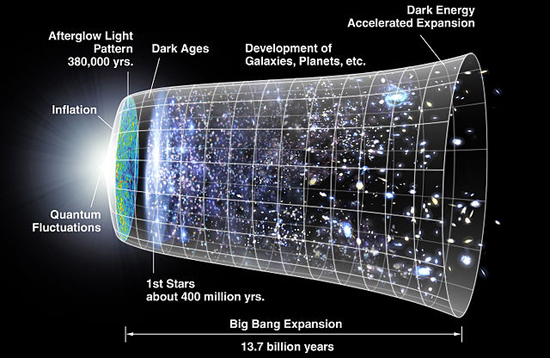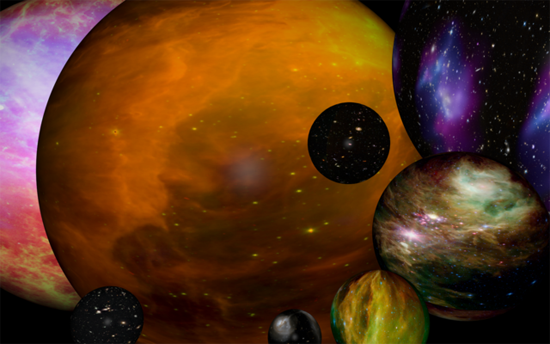Imagine the Big Bangs
Today, we imagine the Big Bangs. The University of Houston's College of Engineering presents this series about the machines that make our civilization run, and the people whose ingenuity created them.
Let's take a journey to outside of our universe. For this visualization, let's make a few assumptions: Imagine the collection of galaxies, stars, planets and black holes that we know exist. Now, imagine a space beyond our known universe. We assume that we're mere observers, unaffected by the events we see. We also imagine that we can witness billions of years in only few minutes. So, what do we see?
We see the birth of our universe. We see an intense and spectacular explosion called "The Big Bang." We see a collection of dense and extremely hot materials (billions of degrees) expanding. The hot matter begins to cool down to millions of degrees, then thousands ... We see stars and planets form and galaxies shape.

Big Bang Expansion. [Time Line of the Universe/Image credit: NASA/WMAP Science Team/Source: Wikipedia]
At some point, our universe will stop expanding. According to scientific theories, our universe begins to shrink. We watch planets, stars and galaxies coalesce. We see the universe shrink until it collapses. Scientists call this "The Big Crunch." So, is it over? Some theories say no.
What? Another Big Bang? In fact, scientists believe that there may be multiple big bangs and multiple universes. We may be dealing with a cyclic multiverse rather than an isolated phenomenon. Let's go back to the first Big Bang that we imagined watching, and reconsider this: Was that really the first Big Bang? Or was it the second? or third? or the nth?
We've travelled far from the old myth of our planet supported on the back of a giant turtle to the recent Multiverse theory. New theories have risen and fallen. Surely no giant turtle supports our world.

Artistic Impression of Multiverse. Wikipedia image, credit: Silver Spoon
The multiverse theory, however, opens the door to a fantastical multi-reality. In one universe, matter may behave unlike anything we can imagine ... while in another universe, a planet like ours may exist but perhaps with some peculiar differences. As Hamlet says to Horatio, "There are more things in heaven and earth, than are dreamt of in your philosophy."
I'm Haleh Ardebili at the University of Houston, where we're interested in the way inventive minds work.
Reference:
Stephen Hawking, The Illustrated A Brief History of Time, Bantam Books, New York, 1996.
'The Universe's 10 Greatest Mysteries', Science Illustrated, pp52-61, July/Aug 2012.
NOVA: The Fabric of the Cosmos, Episode 4: 'Universe or Multiverse', Narrated by Brian Greene, PBS, 2011
This episode was first aired on November 9, 2012